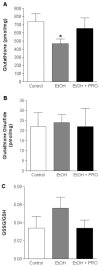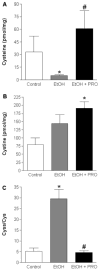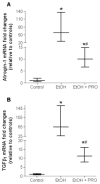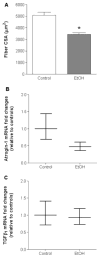Oxidant-induced atrogin-1 and transforming growth factor-beta1 precede alcohol-related myopathy in rats
- PMID: 17721978
- PMCID: PMC3157955
- DOI: 10.1002/mus.20883
Oxidant-induced atrogin-1 and transforming growth factor-beta1 precede alcohol-related myopathy in rats
Abstract
Alcohol-related chronic myopathy is characterized by severe biochemical and structural changes to skeletal muscle. Our goals were to: (1) identify early regulatory elements that precede the overt manifestation of plantaris atrophy; and (2) circumvent these derangements by supplementing alcohol-fed rats with the glutathione precursor, procysteine. After 6 weeks of daily ingestion, before the development of overt atrophy of the plantaris muscle, alcohol increased several markers of oxidative stress and increased gene expressions of atrogin-1 and transforming growth factor-beta1 (TGF-beta1) by approximately 60- and approximately 65-fold, respectively, which were attenuated by procysteine supplementation. Interestingly, after 28 weeks of alcohol ingestion, when overt plantaris atrophy had developed, atrogin-1 and TGF-beta1 gene expression had returned to baseline levels. Together, these findings suggest that alcohol-induced, redox-sensitive alterations drive pro-atrophy signaling pathways that precede muscle atrophy. Therefore, targeted anti-oxidant treatments such as procysteine supplementation may benefit individuals with chronic alcohol abuse, particularly if given prior to the development of clinically significant myopathy.
Figures





Similar articles
-
Procysteine stimulates expression of key anabolic factors and reduces plantaris atrophy in alcohol-fed rats.Alcohol Clin Exp Res. 2009 Aug;33(8):1450-9. doi: 10.1111/j.1530-0277.2009.00975.x. Epub 2009 May 4. Alcohol Clin Exp Res. 2009. PMID: 19426167 Free PMC article.
-
Procysteine increases alcohol-depleted glutathione stores in rat plantaris following a period of abstinence.Alcohol Alcohol. 2010 Nov-Dec;45(6):495-500. doi: 10.1093/alcalc/agq066. Epub 2010 Oct 8. Alcohol Alcohol. 2010. PMID: 20935073 Free PMC article.
-
Molecular and cellular defects of skeletal muscle in an animal model of acute quadriplegic myopathy.Muscle Nerve. 2007 Jan;35(1):55-65. doi: 10.1002/mus.20647. Muscle Nerve. 2007. PMID: 16967495
-
Molecular and cellular events in alcohol-induced muscle disease.Alcohol Clin Exp Res. 2007 Dec;31(12):1953-62. doi: 10.1111/j.1530-0277.2007.00530.x. Alcohol Clin Exp Res. 2007. PMID: 18034690 Review.
-
Biomarkers of Skeletal Muscle Atrophy Based on Atrogenes Evaluation: A Systematic Review and Meta-Analysis Study.Int J Mol Sci. 2025 Apr 9;26(8):3516. doi: 10.3390/ijms26083516. Int J Mol Sci. 2025. PMID: 40331994 Free PMC article.
Cited by
-
Chronic alcohol ingestion changes the landscape of the alveolar epithelium.Biomed Res Int. 2013;2013:470217. doi: 10.1155/2013/470217. Epub 2012 Dec 30. Biomed Res Int. 2013. PMID: 23509726 Free PMC article. Review.
-
Alcohol Induces Zebrafish Skeletal Muscle Atrophy through HMGB1/TLR4/NF-κB Signaling.Life (Basel). 2022 Aug 10;12(8):1211. doi: 10.3390/life12081211. Life (Basel). 2022. PMID: 36013390 Free PMC article.
-
Skeletal muscle adaptations following eccentric contractions are not mediated by keratin 18.J Appl Physiol (1985). 2024 Oct 1;137(4):903-909. doi: 10.1152/japplphysiol.00496.2024. Epub 2024 Aug 22. J Appl Physiol (1985). 2024. PMID: 39169838
-
Calpain-1 is required for hydrogen peroxide-induced myotube atrophy.Am J Physiol Cell Physiol. 2009 Feb;296(2):C363-71. doi: 10.1152/ajpcell.00497.2008. Epub 2008 Dec 24. Am J Physiol Cell Physiol. 2009. PMID: 19109522 Free PMC article.
-
Regular exercise attenuates alcoholic myopathy in zebrafish by modulating mitochondrial homeostasis.PLoS One. 2023 Nov 30;18(11):e0294700. doi: 10.1371/journal.pone.0294700. eCollection 2023. PLoS One. 2023. PMID: 38032938 Free PMC article.
References
-
- Adachi J, Asano M, Ueno Y, Reilly M, Mantle P, Peters TJ, et al. 7-α and 7 β-hydrocycholesterol-5-en 3β-ol in muscle as indices of oxidative stress: response to ethanol dosage in rats. Alcohol Clin Exp Res. 2000;24:675–681. - PubMed
-
- Aoyama Y, Urushiyama S, Yamada M, Kato C, Ide H, Higuchi S, et al. MFB-1, an F-box-type ubiquitin ligase, regulates TGF-beta signaling. Genes Cells. 2004;9:1093–1101. - PubMed
-
- Bechara RI, Pelaez A, Palacio A, Joshi PC, Hart CM, Brown LA, et al. Angiotensin II mediates glutathione depletion, transforming growth factor-beta1 expression, and epithelial barrier dysfunction in the alcoholic rat lung. Am J Physiol. 2005;289:L363–L370. - PubMed
-
- Bodine SC, Latres E, Baumhueter S, Lai VK, Nunez L, Clarke BA, et al. Identification of ubiquitin ligases required for skeletal muscle atrophy. Science. 2001;294:1704–1708. - PubMed
-
- Cederbaum AI, Rubin E. Molecular injury to mitochondria produced by ethanol and acetaldehyde. Fed Proc. 1975;34:2045–2051. - PubMed
Publication types
MeSH terms
Substances
Grants and funding
LinkOut - more resources
Full Text Sources
Medical

